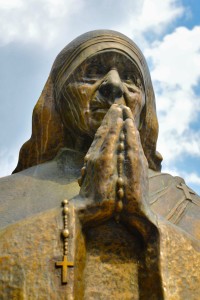
A huge ceremony was held at the Vatican canonizing Mother Teresa as Saint Teresa of Calcutta a few days ago. If you’re not Catholic, you might wonder what all the commotion is over this one religious rite. Most of us believe that she deserved sainthood, but it really depends on your definition of what a saint is.
Mother Teresa is probably one of the most recognizable figures in the world, even 19 years after her death. She worked with the poorest of the poor, not only in India but around the world. In her own words, she believed: “The poor do not need our compassion or our pity; they need our help. What they give to us is more than what we give to them… The poor are our prayer. They carry God in themselves.”
Who Was Mother Teresa?
The woman we know as Mother Teresa was born in Albania in 1910. She left her home at the age of 18, never again to see her mother or sister, first for a convent in Ireland to learn English, then for another convent in India where she would later take her religious vows. She worked as a teacher and headmistress of a school near the Himalayas for almost 20 years before leaving the security of her convent to serve the poor in Calcutta, which she did without a church behind her. It would be almost two more years before the Vatican gave her assistance.
From 1950 through 1997, she worked diligently with the orphans, cripples and homeless around the world. Her small congregation started with 13 women in Calcutta and grew to an army of almost 4,000 at her death working internationally with those in need. She served humbly, refusing the monetary award from the Nobel Peace Prize, instead giving it to her charity. Although she never worked to gain fame for her good deeds, she was respected for her work and honored for it.
Understanding the Catholic Definition of Sainthood
In the broadest terms, a saint is someone who follows the teachings of Jesus Christ. In the early Church, it really referred to those who were living an especially holy life. Over time, the word became more narrowly applied to those people who were recognized after death because of their good deeds. The Catholic Church has a process called canonization, in which a person must meet certain requirements to be universally recognized as a saint. Mother Teresa went through this five-step process beginning in 1999, just two years after her death. Still, it took almost 17 years to complete the process.
- Waiting period of five years following the death. Pope John II waived this period in the case of Mother Teresa.
- Recognizing the individual as a “servant of God.” Evidence as to the candidate’s virtue and holiness is gathered.
- Scrutinizing the evidence to determine if the candidate brought others to a life of prayer through “heroic virtue.”
- Beautification or attributed miracles to the individual. There must be at least one miracle attributed to the candidate. It must be verified. Martyrs do not have to meet this requirement.
- Canonization is the final step. A second miracle must be verified in order for a candidate to be canonized. In Mother Teresa’s case, she was beautified in 2003, but another miracle was not attributed to her until last year.
Many times, Catholics pray to the canonized saints to intercede with God in heaven. For those who aren’t members of the Catholic faith, saints can be looked upon as examples. Whether or not you believe in God as Mother Teresa did, you can still emulate her life and service to the unwanted and unloved in the community.

